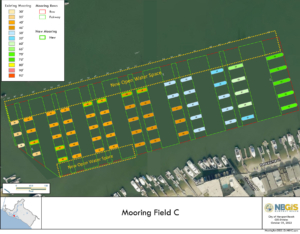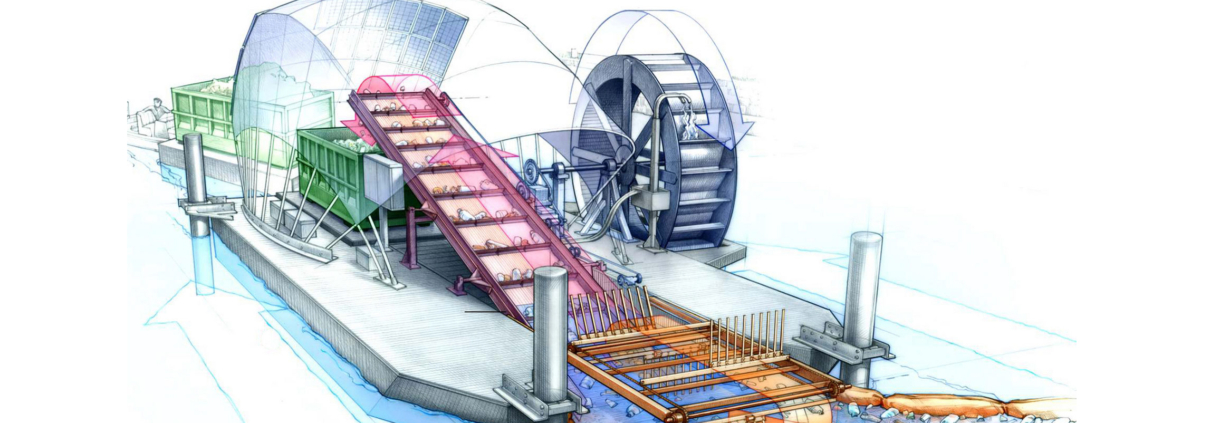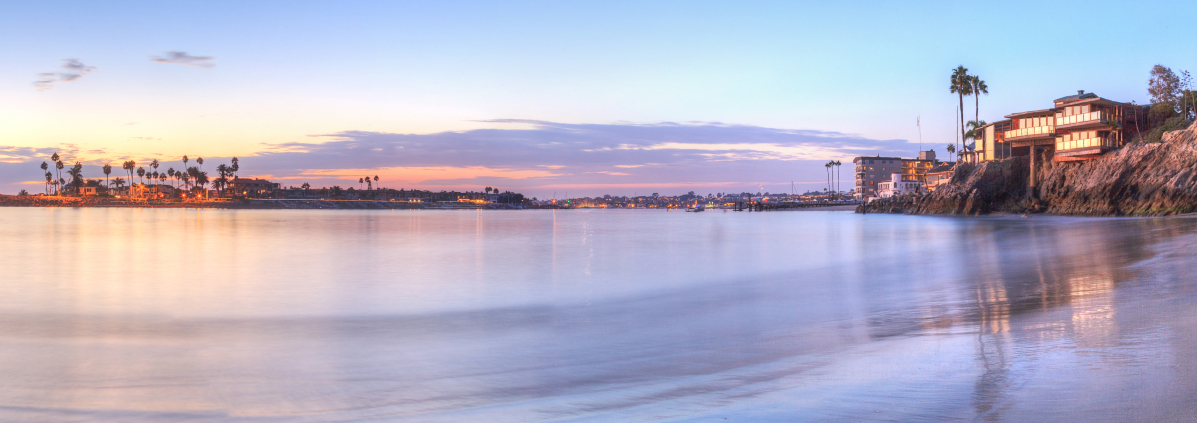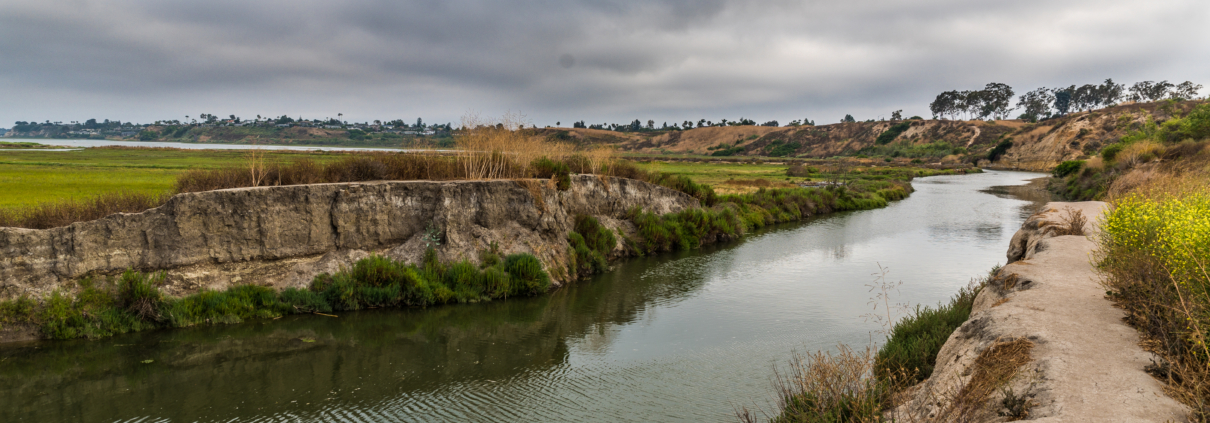Council OKs mooring field reconfiguration pilot program, open water initiative
Source: Stu News Newport – https://stunewsnewport.com/index.php/2-uncategorised/15124-council-oks-mooring-field-reconfiguration-pilot-program-052623

A rendering of what mooring field C would look like after the pilot project with a new double row configuration
City Council this week unanimously approved a pilot project, called the open water initiative, related to mooring field design.
Councilmembers voted 7-0 on Tuesday (May 23) in support of the ordinance that would amend Title 17 (the city’s harbor code) related to mooring standards and permits. The approved action, stemming from Harbor Commission recommendations, will reconfigure mooring field C, which sits between Bay Island and the Balboa Peninsula ferry station.
Councilmember Joe Stapleton explained his support of the project because it will improve navigation, optimize the mooring field space, and adds additional city moorings, which he believes support affordable boating and allows more access to the general public in regards to boating. It will also be a benefit to have wider fairways, increased spacing between moorings in the same row and improved views from the shoreline, he added.
“I’m excited to see where this could go,” Stapleton said.
He will visit the C field often during the pilot project, Stapleton noted. He also encouraged the boaters in the audience to continue to communicate with the council and city staff about what does and doesn’t work.
The contentious item prompted hundreds of emails and comments and a packed council chambers on Tuesday. More than two dozen people spoke during public comment, many who own mooring permits. A majority of the speakers opposed the project.
Councilmember Brad Avery, a longtime boater and former Harbor Commissioner, said he can see the new mooring field setup working. It appears to be a good plan, he added, but this is a test run and they’ll find out how well it works. He hopes people will approach the experiment objectively, he said.
“There’s been a lot of animosity between the NMA and the mooring permit holders and the Harbor Commission and it’s been really difficult. This is something that’s really divided people,” Avery said. “We need to give the trial (a chance), we need to have the trial. We need to hold it and we need people to give it a good shot.”
Ultimately, there is a benefit here, he said, the accessibility to the moorings, providing more space to safely operate in the channels and better maneuverability.
“We’re trying to get to the same place, but this is just a change that’s difficult,” Avery noted. “I think overall it’s a good change.”
Nobody is working against the mooring permittees, he added.
“Everyone’s trying to get to something that’s better for everybody. I guess coming from the government it’s not very satisfying, is it?” he joked. “But I don’t see how this is not going to work, frankly. We’ll see.”
Everyone is looking for something that’s safe, accessible, recreation-friendly, agreed Councilmember Robyn Grant, but the problem is they don’t have consensus from all stakeholders on how to accomplish that. It’s unfortunate there’s this much disagreement on these issues, she added. The good news is that this is a pilot program and they will study it as it moves along and modify it as needed. If it’s not workable at all, due to a safety issue or something that isn’t fixable, they’ll return and try again.
Addressing one of the mooring permittees’ key concerns about transferability, Avery noted that his father got a mooring permit in the 1960s and it was eventually transferred to him. He has a large powerboat and tried to get on the mooring, located in the H field, a few times.
“I just figured out I couldn’t safely get on that mooring,” said Avery, who later sold his permit. “So I get the fear factor of change on this.”
All existing mooring permits will remain transferrable and the harbor department practices that “a mooring permit is a mooring permit is a mooring permit” in perpetuity, until revoked or surrendered, confirmed Newport Harbormaster Paul Blank. If an existing mooring permit holder transfers his or her permit to a new person, it’s the same permit number and can still continue to be transferred to other people down the line.
“If – and it’s a big if – new moorings are created as a result of this pilot program or roll-out in furtherance of the program, the permits for those new moorings will have different transferability (rules), essentially be non-transferrable and so the city will maintain them. The permits will remain in the name of the city and the city will be able to lease those moorings out,” Blank explained.
Addressing some other public comments, Avery clarified that under the new program, boaters can orient their vessel in either direction in the field with any of the configurations, he noted. His father’s mooring was up three rows in the field, Avery said, and recounted how he thread his way through the field to get to his mooring.
“When you go out…you might leave in calm weather, calm tides, slack tide; and then come back and it’s a whole other program,” Avery said. “There’s no dangerous roads, there’s dangerous drivers, they’re just driving too fast on roads that aren’t designed for it or driving recklessly, and the same is true with boat operation.”
“Each captain’s got to judge his or her ability to get on the mooring and your crew and the current,” he added.
Replying to more public comments of concern, Avery noted that while the new configuration may increase traffic with the wider channels, there’s always been traffic through the mooring fields. Ultimately, it’s advantageous for the permittees so they can easily access their moorings, he added.
Tuesday’s approved action will also appropriate $75,000 for consulting services and permitting with the California Coastal Commission and other agencies, $275,000 for engineering and construction related to the realignment of the moorings in the subject pilot project, and $60,000 for post-pilot project consulting services for environmental review and permitting necessary to expand the reconfiguration recommendations to the city’s remaining mooring fields.
The pilot project consists of reconfiguring the C mooring field to double-row moorings, replacing existing single-row moorings and that boats of like sizes be consolidated into the same row(s). To allow for testing of the new layout and for making any necessary adjustments, only one or two rows will be reconfigured initially. The fully completed reconfiguration will include regular inspections from harbor department staff as well as interviews with affected permittees and other stakeholders. The relocation of moorings and permittees for the first one or two rows is estimated to take two weeks. Subsequently, the full reconfiguration of the remaining rows in the C field would take approximately 30 days.
The new double-row mooring system would be in the same location and serve the same purpose as the moorings being replaced. The reconfiguration would result in a meaningful increase in open water space within and immediately adjacent to the mooring field, staff noted in the report. The double-row mooring arrangement allows better utilization of the available area within the mooring field, grouping of like-sized boats together, more open space between/abreast of boats moored in the same row, and expanded, more well-defined fairways between the double-rows.
Staff noted that the more efficient use of the space within the mooring field provides mooring permittees with more room to maneuver in three of four directions onto and off their moorings, and other mariners significantly more well-defined pathways through the field, plus allows for the addition of several new moorings. The double-row mooring arrangement will reduce the footprint occupied by boats within the mooring field and increase navigable waterways both within and adjacent to the existing mooring field boundaries.
Blank explained that the population of existing moorings and their lengths has been assessed on several surveys and provided to the engineers.
“The engineers will guide us in determining, based on that population of existing moorings of existing lengths, what the best arrangement for them is,” Blank explained. “That information will be fed to GIS and then a program will be carried out to actually move the moorings into that configuration based on the engineering.”
The mooring length is listed on each permit, Blank said, so the maximum allowed length for each permit already exists today. Based on the pilot program, the city may rearrange the location of that mooring, which they currently already have the permission to do, he added. They will be arranged by allowed size. If a permit holder has a boat smaller than what’s designated on the permit, it won’t be changed. They might be in a row bigger than what their permit allows, but it will absolutely not be in a row for vessels smaller than what their permit allows.
There is no uniformity of boat lengths in the rows at mooring field C. Large vessels (up to 75 feet) protrude into fairways, Blank explained. Many vessels are moored outside the designated field boundaries. Staff commented that it’s poor utilization of limited water space along the main channel of Newport Harbor.
Under the new pilot program, the new configuration at field C will provide improved utilization of space, according to staff. Every row will be in substantial compliance with harbor design standards, with boats spaced 50 to 55 feet on center and fairways ranging from 60 to 100 feet. Row sizes are reduced from as many as seven boats down to five boats. The plan will also add seven new long-term city moorings. It will also add two acres of new open water along the main channel (approximately 1200 feet by 70 feet). The wider channel will offer greater distance between residential properties and moored boats. Conformance to the engineer’s design specifications will be field verified after completion of the first double row, then the balance of rows will be completed.
If for some reason the pilot program doesn’t work out, they can easily change the code back, City Attorney Aaron Harp confirmed.
During public comment, boaters raised concerns about transferability, safety and aesthetics.
The proposed plan compromises boating safety, emphasized John Fradkin, a mooring permittee and Newport Mooring Association board member. Proponents argue that the increased distances in three dimensions make the new configuration safer than the current layout.
“This is a ludicrous argument and shows a real misunderstanding of the challenges in approaching or departing a mooring,” Fradkin said. “The wind and tide do not care about all that extra space in the three other directions.”
Chris Bliss, a 30-year mooring owner in C field, also opposed the plan.
“I’ve never been aware of any kind of safety issue regarding other vessels or swimmers or anything in the C field,” he said.
The currents are often very strong there, sometimes exceeding five knots, that if boats are placed closer together as proposed it could be very hazardous for people getting on and off their moorings, Bliss said. This type of double-row configuration isn’t seen in other harbors, noted the longtime sailor.
“It’s very, very difficult to navigate and I think it’s going to be dangerous for mariners and boaters,” Bliss said.
In support of the project, speakers said the project will improve safety, navigation and usage.
This has been a long time in the works, said Former Mayor Marshall “Duffy” Duffield. He worked on the boundaries of the mooring fields for seven of his 10 years on the Harbor Commission. They tried to get this going many times, he noted, but they never had a harbor department to study it. Now, the commission and the new department (formed in 2017) can work together to make the moorings a fair playing field. He commended the commissioners and staff who worked on the project.
“This is the most fabulous improvement to our harbor that I can think of,” Duffield said.
It seems like they’ve worked out every detail, he noted, but it’s a test and they will examine every aspect of the pilot program.
“We’re going to make some mistakes and we’ll learn about them and then we’ll correct them,” Duffield said. “Then we’ll go forward and that’s what it’s for.”
Former Newport Harbormaster Dennis Durgan also supported the mooring field reconfiguration. He spoke on Tuesday as the chairman of the Newport Harbor Foundation. The project will improve the safety and the appearance of the mooring fields, as well as open up the waters for the benefit of all harbor users.
The program will also better define the mooring field rows, which will make navigating them safer. Placing like-sized boats in the same rows, instead of the current random placement, will make the rows more uniformed, Durgan explained. Widening the fairways will make for easier and safer navigation as well, he added.
“As councilmembers, this decision is straightforward, there is no downside,” Durgan said.
Since taking over the responsibility for administration of the moorings in 2017, the harbor department has received requests to extend the permitted length of several offshore moorings. The city doesn’t have an effective, objective method for review and approval of such requests. The results were a disorganized arrangement of moorings of various sizes throughout the mooring fields.
A Harbor Commission subcommittee was formed and worked on recommendations for improvements to the mooring field utilization and a process to accommodate requests from permittees to adjust the size of their permitted moorings. The subcommittee’s focus included ensuring safe navigation for all users of the harbor in and around the mooring fields, not just the mooring permittees. Other considerations included:
–Grouping vessels of similar size in the same row for the most efficient use of the limited space within each mooring field and potentially opening space for improved navigation and additional moorings.
- Ensuring the fairways between the rows provide for safe navigation even in adverse conditions.
- Acknowledging that fairways between rows are considered navigable water for all mariners, not just the mooring permittees.
- Providing staff and the community with guidance for mooring extension and size exchange requests.
- Maximizing the use of space within the mooring fields in the most effective manner possible.
- The opportunity to utilize space freed up by the more efficient arrangement within the fields to increase open water for all harbor users and add a small number of new moorings.
Over the last several months, several public hearings were held to discuss the issue, as well as stakeholder meetings and a work session hosted by the Newport Mooring Association. At the March 8 meeting, the Harbor Commission approved several recommendations, which will: Allow more efficient arrangement of the offshore moorings; open waterways on three of four sides for each moored vessel; open waterways between rows within the mooring fields; open waterways on the boundary edges of the mooring fields and create a process by which requests for mooring length extensions can be effectively accomplished without compromising the efficient arrangement of moorings within a field. The recommendations also suggest some clean-up and clarification language to the code, as well revisions to the section that defines the conditions in which a mooring size exchange or extension within a row designated for larger moorings can be requested by a permittee.





Leave a Reply
Want to join the discussion?Feel free to contribute!